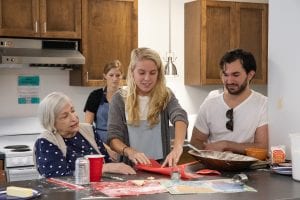Many thanks to Nathalie Dupree, cookbook author and biscuit maker extraordinaire, for spending an afternoon with my Intro to Southern Studies students last week. Her demonstration of biscuit making provided many helpful pointers as well as some delicious biscuits hot from the oven in the kitchen of McAlister Residence Hall.
She told students that flour grown in the South is a softer flour, necessary for a tender biscuit. Southern flour brands use names like “Lily White” and “Martha White” to promote their bleached flour, which Ms. Dupree also prefers. (A whole wheat biscuit, something I said I once enjoyed baking, is “an oxymoron.”) Northern flours are better for making bread, whereas all-purpose flours like Pillsbury Gold Medal work for both bread or biscuit baking, but produce a less-than-ideal version of either, according to Ms. Dupree.
The recipe she demonstrated included two parts self-rising Southern bleached flour and one part heavy cream. It’s not just a matter of measuring; flour behaves differently each time, so bakers must feel the dough as it gets wetter, while stirring as little as possible. The best way to do this is to use a large, wide bowl. Ms. Dupree had brought along her own shallow wooden bowl, noting that once upon a time, “Everybody’s grandmother had a biscuit bowl.” She explained that when using soft flour, one can make a well in the flour and pour in the cream, which will sit on top of the flour while the flour is gently mixed from the outside in. Good bakers have a feel for the right consistency of the dough, which takes practice.
To roll out the biscuit dough, Ms. Dupree used a method she’s developed after traveling to many sites demonstrating her biscuit making. Rather than a rolling pin, she used two flexible cutting board sheets to press the dough to the desired thinness. Next she folded the flexible sheet in half, then again from the other direction, making four layers of dough that could be flattened back to the original thinness with the second cutting board sheet. This should be done at least three times to create layers in the dough.
She baked these biscuits at 450 degrees for 20 minutes before checking on their progress and turning the pan around to get a more even bake. All bakers must learn how their particular oven cooks—no matter how big & fancy, or small and inexpensive, the oven (and the small pan for today’s biscuits could’ve fit into a countertop oven). Only trial and error will enable you to discover the right temperature and time for your home oven.
 As students began mixing another batch of dough, Ms. Dupree encouraged everyone not to be afraid of making mistakes at home.. She opined that Southern women, in particular, believe that “they are a failure if they cannot make biscuits the first time. . . People still assume that a woman is born, coming out of the womb, holding a biscuit bowl.”
As students began mixing another batch of dough, Ms. Dupree encouraged everyone not to be afraid of making mistakes at home.. She opined that Southern women, in particular, believe that “they are a failure if they cannot make biscuits the first time. . . People still assume that a woman is born, coming out of the womb, holding a biscuit bowl.”
She advised students to “spend ten dollars on ingredients for biscuits” and make a lot of batches, using different recipes. By the time you’ve used all those ingredients, “you will make a biscuit that you can live off the rest of your life.”
One final tip: “If you have leftover biscuits, you can melt butter in a pan and fry ‘em up.”




